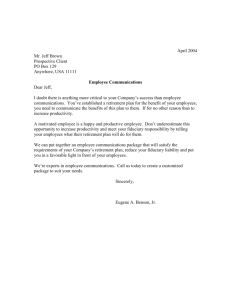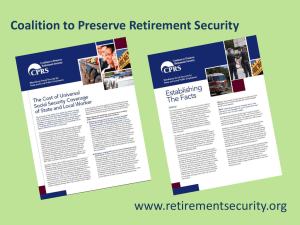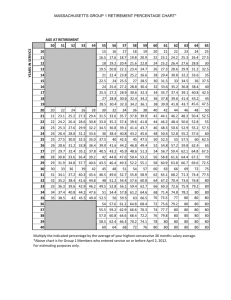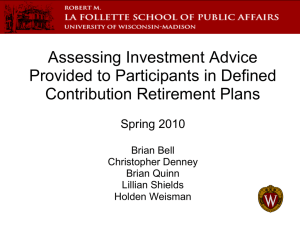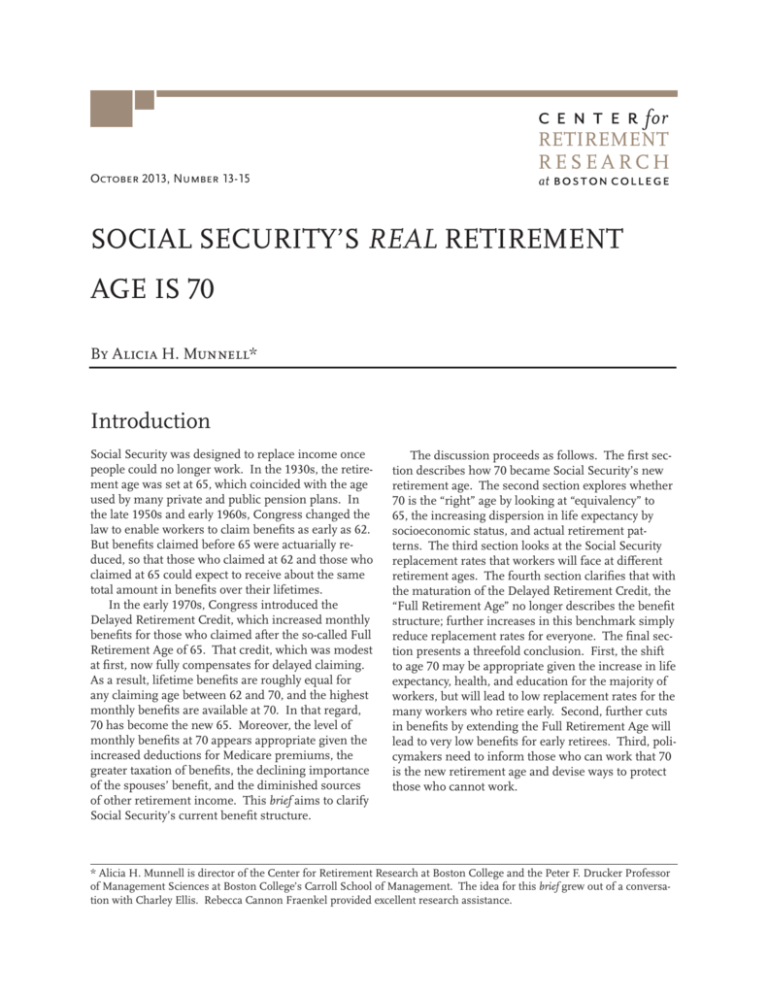
October 2013, Number 13-15
RETIREMENT
RESEARCH
SOCIAL SECURITY’S REAL RETIREMENT
AGE IS 70
By Alicia H. Munnell*
Introduction
Social Security was designed to replace income once
people could no longer work. In the 1930s, the retirement age was set at 65, which coincided with the age
used by many private and public pension plans. In
the late 1950s and early 1960s, Congress changed the
law to enable workers to claim benefits as early as 62.
But benefits claimed before 65 were actuarially reduced, so that those who claimed at 62 and those who
claimed at 65 could expect to receive about the same
total amount in benefits over their lifetimes.
In the early 1970s, Congress introduced the
Delayed Retirement Credit, which increased monthly
benefits for those who claimed after the so-called Full
Retirement Age of 65. That credit, which was modest
at first, now fully compensates for delayed claiming.
As a result, lifetime benefits are roughly equal for
any claiming age between 62 and 70, and the highest
monthly benefits are available at 70. In that regard,
70 has become the new 65. Moreover, the level of
monthly benefits at 70 appears appropriate given the
increased deductions for Medicare premiums, the
greater taxation of benefits, the declining importance
of the spouses’ benefit, and the diminished sources
of other retirement income. This brief aims to clarify
Social Security’s current benefit structure.
The discussion proceeds as follows. The first section describes how 70 became Social Security’s new
retirement age. The second section explores whether
70 is the “right” age by looking at “equivalency” to
65, the increasing dispersion in life expectancy by
socioeconomic status, and actual retirement patterns. The third section looks at the Social Security
replacement rates that workers will face at different
retirement ages. The fourth section clarifies that with
the maturation of the Delayed Retirement Credit, the
“Full Retirement Age” no longer describes the benefit
structure; further increases in this benchmark simply
reduce replacement rates for everyone. The final section presents a threefold conclusion. First, the shift
to age 70 may be appropriate given the increase in life
expectancy, health, and education for the majority of
workers, but will lead to low replacement rates for the
many workers who retire early. Second, further cuts
in benefits by extending the Full Retirement Age will
lead to very low benefits for early retirees. Third, policymakers need to inform those who can work that 70
is the new retirement age and devise ways to protect
those who cannot work.
* Alicia H. Munnell is director of the Center for Retirement Research at Boston College and the Peter F. Drucker Professor
of Management Sciences at Boston College’s Carroll School of Management. The idea for this brief grew out of a conversation with Charley Ellis. Rebecca Cannon Fraenkel provided excellent research assistance.
2
Center for Retirement Research
How 70 Became Social
Security’s Retirement Age
How Does 70 in 2013 Compare with 65
in 1940?
When Social Security benefits were first paid in 1940,
the retirement age was 65. The notion was that 65
was the age at which people could no longer work and
needed benefits to support themselves. No benefits
were paid before that age, and no increments were
added for claiming later.
In 1956, Congress gave women the option to retire
as early as age 62 on a reduced monthly benefit. The
reason for the change was to allow married women,
who were typically the younger member of the couple,
to retire and claim benefits at the same time as their
husbands. Congress made the option available to all
women, so as not to discriminate against unmarried
women. Congress extended this option to men in
1961, a recession year that made early retirement an
attractive policy option. The reduction in monthly
benefits was designed so that, for a person with average life expectancy, the cost of lifetime benefits would
be much the same whether benefits were claimed at
62 or 65.1 That is how things remained for about a
decade: actuarially reduced benefits were available at
62 and the maximum benefit at 65.
In 1972, Congress introduced a Delayed Retirement Credit, which increased benefits by 1 percent of
the “Full Retirement Age” benefit for each year of delay up to age 72. The result was that those who retired
later got a little bonus for delaying. But a 1-percent
credit did not come close to compensating for the fact
that late claimers had to wait and would get benefits
over fewer years. In 1983, the age was lowered to
70 and the adjustment was raised to 3 percent and
scheduled to increase gradually to 8 percent for those
turning 65 in 2008. At this point, the adjustment provided by the Delayed Retirement Credit is actuarially
fair – that is, for a person with average life expectancy,
it keeps lifetime benefits constant for those who claim
between the Full Retirement Age and 70.
The question is whether 70 is the right age for
retirement and whether the benefit provided at that
age is appropriate.
People are living longer in 2013 than they did in 1940;
the increase has been about seven years for both
men and women (see Figure 1). This increase in life
expectancy suggests that people may have outgrown
the physical need for retirement at 65 that may have
existed in earlier years.
Is 70 the “Right” Age?
“Right” can mean a number of things. Here we consider three possible metrics: 1) How does 70 in 2013
compare with 65 in 1940 in view of the increase in life
expectancy?; 2) How does the increase in life expectancy vary by socio-economic status?; and 3) How
does 70 compare with actual retirement patterns?
Figure 1. Life Expectancy at 65 by Gender, 1940
and 2015
25
Years
20
15
1940
2015
21.6
19.3
14.7
12.7
10
5
0
Men
Women
Source: U.S. Social Security Administration (2013).
The question is how these additional years of life
expectancy should be spent. The following reports
on two measures. The first is the age at which the
expected number of years in retirement remains
unchanged, using 1940 as the base year. This should
be viewed as the limiting case because it assumes
that all of the adult years added by improved mortality
should be spent in the labor force. The other measure identifies the retirement age at which the ratio
of the expected number of years spent in retirement
to the expected number of years working – assuming
a starting age of 20 – remains constant. This seems
like a better measure because it distributes gains in
life expectancy into both working years and retirement years. Table 1 on the next page shows that the
limiting case suggests a retirement age of 72 in 2020,
while the one that distributes gains between work and
leisure suggests age 70.
3
Issue in Brief
Table 1. Retirement Age Equivalent to Age-65
Retirement in 1940, Based on Rising Life
Expectancy (In Years: Months)
Age at which:
Year
Expected retirement
years remain constant
Ratio of expected
retirement to working
years remains constant
1940
65:00
65:00
1950
66:04
65:11
1960
67:05
66:08
1970
68:08
67:06
1980
69:05
68:00
1990
70:01
68:06
2000
70:10
69:00
2010
71:07
69:07
2020
72:04
70:02
2030
73:01
70:08
Note: For the ratio of expected retirement to working years,
people are assumed to start work at 20.
Source: U.S. Social Security Administration (2004).
How Does Life Expectancy Vary by
Socioeconomic Status?
The previous exercise is based on the assumption that
all groups of workers face average mortality risk. To
the extent that such an assumption does not hold,
an increase in the retirement age to 70 could involve
a significant additional burden for many. An enormous amount of evidence, both for the United States
and other developed countries, shows that richer,
better-educated people live longer than poorer, lesseducated people. According to calculations from the
National Longitudinal Mortality Survey, which tracks
the mortality of people originally interviewed in government surveys, men whose 1980 family income fell
in the top 5 percent had a life expectancy at all ages
that was about 25 percent longer than those in the
bottom 5 percent.2
Moreover, the discrepancy in life expectancy between those with high and low socioeconomic status
is getting larger with each cohort.3 This trend is
evident in mortality differentials for a sample of male
workers age 60 and over, covered by Social Security.
Table 2 shows the first age at which less than half the
sample was still alive for those in the top half of the
earnings distribution and for those in the bottom half.
(Earnings were measured at peak earnings years (4555) and therefore serve as a proxy for socioeconomic
status.) For male workers who were born in 1912 and
lived to age 60, the difference between the benchmark
age for high and low earners was only two years. For
those born in 1941, the difference between the ages
for low and high earners had increased to six years.
This strong and increasing relationship between
earnings and life expectancy makes it difficult to design any equitable retirement benefit structure.
Table 2. Age at Which Less than Half the Sample
was Still Alive, by Birth Year and Earnings Group
Earnings group
Year of birth
1912
1922
1932
1941
Bottom half
77
78
79
80
Top half
79
81
84
86
Source: Waldron (2007).
How Does 70 Compare with Actual
Retirement Patterns?
In considering whether 70 is the correct age, it is also
useful to look at current work patterns to see the extent to which people are in the labor force around that
age. Figure 2 presents labor force participation for
men by age for 2012 (the most recent year for which
data are available), and for two earlier years, 1970 and
Figure 2. Labor Force Participation Rates of Men
Age 50-74, 1970, 1985, and 2012
100%
80%
60%
40%
1970
1985
2012
20%
0%
50
55
60
Age
65
70
Source: U.S. Census Bureau, Current Population Survey
(CPS) (1970, 1985, 2012).
4
Center for Retirement Research
1985. The figure shows that only about 30 percent of
men are currently employed at age 70. This percentage has risen substantially since 1985 due to a host of
factors, which could continue to push participation
higher.4 The fact that the age-70 labor force participation rate in 2012 is below the 1970 rate also suggests
that labor force activity at older ages could increase
further. (Remember that both Social Security and
defined benefit plans created strong incentives not to
work beyond 65 in the 1970s and 1980s.) The question is what fraction of the population could work to
70, and what fraction would justify characterizing 70
as the “correct” age.
Again, as in the case of life expectancy, it is useful
to look at who is working at older ages. Table 3 pools
data over a 13-year period to examine the relationship between narrowly defined age and educational
groups. The data show a strong positive relationship
between educational attainment and labor force activity. Clearly, working longer is more attractive to those
with more education and more interesting jobs. But,
within each group, a greater proportion might work
until 70 if they understood the economic security offered by higher monthly Social Security benefits.
How Do Replacement Rates
Vary by Age?
To get a sense of the stick as well as the carrot
requires some knowledge about how much people
will receive from Social Security at different claiming
Table 3. Labor Force Participation by Age Group
and Education Level, 1999-2012
Educational attainment
Age
High
school
Some
college
College
50-58
69 %
75%
79 %
85%
59-61
57
62
68
72
62-64
42
50
55
62
65-67
29
35
39
47
68-70
22
25
28
34
71-73
15
18
21
30
74-76
10
13
16
20
77-79
7
10
12
16
80-83
5
6
8
11
Advanced
Sources: Updated data from Haider and Loughran (2001);
and 1999-2012 CPS.
ages. Most people do not understand the relationship
between claiming age and monthly benefits. As Table
4 shows, claiming at 62 instead of 70 cuts the monthly benefit almost in half, from an illustrative $1,000
to $568. Given that Social Security is a particularly
valuable type of income – inflation adjusted and lasts
for a lifetime – it generally makes sense for workers
to postpone claiming as long as possible to get the
highest monthly amount, assuming they are in good
health for their age.
Table 4. Illustrative Monthly Social Security
Benefits by Claiming Age
Claiming age
Monthly benefit
70
$1,000
67
818
65
707
62
568
Source: Authors’ calculations from U.S. Social Security
Administration (2013).
To determine the extent to which people can maintain their standard of living in retirement, it is more
useful to focus on replacement rates – benefits as a
percent of pre-retirement earnings – rather than dollar
amounts. Figure 3 on the next page shows replacement rates for the medium earner, as reported by the
Social Security Administration, at ages 70, 65, and 62
over the period 1980-2030. Replacement rates for all
three ages incorporate the effect of the increase in the
Full Retirement Age from 65 to 66 and the scheduled
increase to 67. The age-70 replacement rates reflect
the increase in the Delayed Retirement Credit from 3
percent to 8 percent over the period 1983-2008.
Social Security replacement rates for those with
medium earnings who claim at age 70 will stabilize
around 50 percent. But the reported replacement
rates overstate the amounts that retirees will actually get in retirement. First, premiums for Medicare
Parts B and D are automatically deducted from Social
Security benefits, and these premiums are scheduled to rise substantially over time.5 Second, Social
Security benefits are taxed under the personal income
tax. Individuals with more than $25,000 and married couples with more than $32,000 of “combined
income” have to pay taxes on up to 85 percent of their
Social Security benefits.6 Since the thresholds are not
indexed for growth in average wages or even for infla-
5
Issue in Brief
replacement rates of 24 percent. Retiring at 62 will
not be a reasonable option for those who have any
ability to stay in the labor force. Those who retire at
65 will receive a benefit equal to 31 percent of preretirement earnings, a very modest base particularly
given the extremely low balances in 401(k) plans.
Figure 3. Social Security Replacement Rates for
Medium Earner at 70, 65, and 62, by Year Retiree
Reaches 65
70%
60%
50%
What Does it Mean to Change
the “Full Retirement Age”?
40%
30%
20%
10%
0%
1980
If 70 is the age at which Social Security expects most
people to retire and at which it pays a benefit that
serves as the base for a secure retirement, what does
the “Full Retirement Age” mean? What does it mean
that it has moved from 65 to 66 and is scheduled to
move to 67 for workers born in 1960 or later? And
what does it mean to increase the Full Retirement
Age beyond the age-67 threshold already scheduled
under current law?
The Delayed Retirement Credit has rendered the
Full Retirement Age a largely meaningless concept.
It does not describe the age when benefits are first
available. That is age 62. It does not describe the
age when monthly benefits are adequate. That is age
70. Yet workers appear to respond to changes in announced retirement ages. Figure 4 on the next page
shows that participants in the Health and Retirement
Study subject to a Full Retirement Age of 66 retire
later than those with a Full Retirement Age of 65.
And policymakers couch across-the-board benefit
cuts in terms of the Full Retirement Age. When the
Full Retirement Age moves from 66 to 67 as scheduled under current law, benefits for those claiming at
70
65
62
1990
2000
2010
2020
2030
Source: Social Security Administration (2013); and Myers
(1993).
tion, the percentage of recipients whose benefits are
subject to tax increases over time. (Note that the full
Social Security benefit is considered for tax purposes,
even though the Medicare Part B premium is deducted before payment.)
Table 5 shows estimates of the “net” Social
Security replacement rates, which take into account
Medicare and taxes, over time. The ultimate net
replacement rate at age 70 will equal 43 percent,
once the Full Retirement Age has moved to 67. This
replacement rate will provide a solid base on which
to add 401(k) savings and home equity for a secure
retirement. Those who retire at 62, however, will see
Table 5. “Net” Replacement Rate for Medium Worker by Retirement Age, 1980-2030
Claiming age
1980
1990
2000
2010
2020
2030
70
51%
49%
49%
53 %
48%
43 %
65
48
42
37
38
34
31
62
38
33
29
28
26
24
Note: Year is the date a retiree reaches age 65. Replacement rate is net of Part B and D premiums, as well as taxation of
benefits. Part B SMI deduction for 2030 assumes SMI continues to cover 26 percent of plan costs and uses Medicare Trustees’ Report enrollment and cost growth assumptions. The assumptions are that the beneficiary has enough other income
to have benefits taxed (about $10,000 in 2030) and that the tax rate is 12.5 percent.
Sources: Authors’ calculations based on Centers for Medicare and Medicaid Services (2013); and U.S. Social Security Administration (2013).
6
Center for Retirement Research
Figure 4. Retirement Rate, by Social Security
Full Retirement Age
30%
FRA = 65
FRA = 66
20%
10%
0%
62
62.5
63
63.5
64 64.5
Age
65
65.5
66
Source: Coe, Khan, and Rutledge (2013).
each age will be about 7 percent lower, for life. Benefits at 62 will continue to be 57 percent of benefits at
70, but they will be 7 percent lower for claims at each
age.
Increasing the Full Retirement Age to, say, 70
(after it reaches 67) would be equivalent to about a
20-percent reduction in benefits. The stated benefit
for those claiming at 70 would decline to a 41-percent
replacement rate (see Table 6), and the “net” benefit
would be in the 30-percent range. Those levels would
no longer be adequate for those working to 70 and
would be grossly inadequate for anyone claiming earlier. Some could offset the cut in monthly benefits by
working longer, but many would not be able to do so.7
Conclusion
The maturation of the Delayed Retirement Credit has
created a new Social Security benefit structure. Working until 70 is the way for people to have an adequate
benefit on which they can build for a secure retirement. The shift to age 70 may be appropriate given
the increase in life expectancy, health, and education
for the majority of workers, but it will lead to low
replacement rates for the many workers who retire
early. Further cuts in benefits by extending the “Full
Retirement Age” will lead to very low benefits for
early retirees.
This discussion is not to argue that Social Security
benefits can never be cut. People are healthier, better
educated, have less physically demanding jobs, and
can work longer. They are also living much longer.
So keeping monthly benefit levels unchanged results
in ever increasing costs. But constantly reducing
benefit levels by increasing the Full Retirement Age is
very hard on those who cannot change their retirement date. If we want to cut benefits, it makes much
more sense to directly change the benefit formula.
Such an approach allows for larger cuts for the
higher-paid than for those at the bottom of the earnings distribution.
Eliminating the Full Retirement Age would dramatically clarify Social’s Security benefit structure.8 It
would clearly signal that claiming at age 70 provides
the appropriate benefit and would encourage people
to work longer. Eliminating the concept would also
force policymakers to call a cut a cut, and perhaps
target reductions where they would cause less pain.
Table 6. Social Security Replacement Rates for Medium Earner by Full Retirement Age
Full Retirement Age
Claiming age
Current policy
66
Hypothetical
67
68
69
70
70
54 %
51 %
48 %
46 %
41 %
65
38
36
33
30
27
62
31
29
26
24
22
Note: This table assumes that Social Security targets a 41.1 percent replacement rate at the Full Retirement Age.
Source: Author’s calculations and U.S. Social Security Administration (2013).
Issue in Brief
7
Endnotes
1 The intuition for the size of the reduction can be
seen from the fact that the average life expectancy
at age 65 in 1960 was about 15 years. A worker who
claimed at 62 collected benefits for three additional
years or about 20 percent longer (3 years/15 years).
If an individual were to receive benefits for 20 percent
longer, the only way to keep the cost to the system
constant would be to pay 20 percent less each year.
2 Deaton (2002). See also Waldron (2013).
3 Waldron (2007).
4 In addition to the factors cited above – the increase
in Social Security’s Delayed Retirement Credit and
longer life expectancy – other potential influences
on rising labor force participation include the shift
in employer pensions to defined contribution plans,
workers’ rising educational levels, improved health,
the trend toward less physically demanding jobs, a
preference among men to retire at the same time as
their working spouses (who tend to be younger), the
decline of retiree health insurance, and non-pecuniary
factors such as a desire to stay actively engaged in the
workforce.
5 Centers for Medicare and Medicaid Services (2013);
U.S. Social Security Administration (2013).
6 Combined income is adjusted gross income as reported on tax forms plus nontaxable interest income
plus one half of Social Security benefits.
7 Interestingly, those who retire at age 70 cannot
replicate their previous monthly benefit by working
longer, because the Delayed Retirement Credit is not
applicable after 70. No matter what they do, they will
see a reduction in their monthly as well as lifetime
benefits. Right now, this is not a significant problem.
The age-70 retirees today are largely lawyers, doctors,
and Ph.Ds., as discussed above. Moreover, if age 70 is
considered the “correct” age, it is not necessary to incent people to work longer. But if retirement patterns
change and the correct age is deemed to be more than
70, then policymakers will need to consider extending
the Delayed Retirement Credit beyond age 70.
8 A number of specific provisions are linked to the
Full Retirement Age. An earnings test applies before
age 66 (the Full Retirement Age) but not thereafter.
Widow and spousal benefits are reduced if claimed
before the Full Retirement Age and not thereafter.
Workers can claim spousal benefits at the Full Retirement Age and then subsequently claim their own
benefits.
8
References
Centers for Medicare and Medicaid Services. 2013.
Annual Report of the Boards of Trustees of the Federal
Hospital Insurance and Federal Supplementary Medical Insurance Trust Funds. Washington, DC: U.S.
Government Printing Office.
Coe, Norma B., Mashfiqur R. Khan, and Matthew S.
Rutledge. 2013. “How Important Is Medicare Eligibility in the Timing of Retirement?” Issue in Brief
13-7. Chestnut Hill, MA: Center for Retirement
Research at Boston College.
Deaton, A.S. 2002. “Policy Implications of the Gradient of Health and Wealth.” Health Affairs 21(9):
13-30.
Haider, Steven and Davis Loughran. 2001. “Elderly
Labor Supply: Work or Play?” Working Paper 4.
Chestnut Hill, MA: Center for Retirement Research at Boston College.
Myers, Robert J. 1993. Social Security. Fourth Edition.
Philadelphia, PA: Pension Research Council, University of Pennsylvania Press
U.S. Census Bureau. Current Population Survey, 1970,
1985, 1999-2012. Washington, DC.
U.S. Social Security Administration. 2013. The Annual
Report of the Board of Trustees of the Federal OldAge and Survivors Insurance and Federal Disability
Insurance Trust Funds. Washington, DC: U.S.
Government Printing Office.
U.S. Social Security Administration. 2004. Life Table
Functions Based on the Alternative 2 Mortality Probabilities in the 2004 Trustees Report (unpublished).
Waldron, Hilary. 2007. “Trends in Mortality Differentials and Life Expectancy for Male Social SecurityCovered Workers, by Socioeconomic Status.”
Social Security Bulletin 67(3).
Waldron, Hilary. 2013. “Mortality Differentials by Lifetime Earnings Decile: Implications for Evaluations
of Proposed Social Security Law Changes.” Social
Security Bulletin 73(1).
Center for Retirement Research
RETIREMENT
RESEARCH
About the Center
The mission of the Center for Retirement Research
at Boston College is to produce first-class research
and educational tools and forge a strong link between
the academic community and decision-makers in the
public and private sectors around an issue of critical importance to the nation’s future. To achieve
this mission, the Center sponsors a wide variety of
research projects, transmits new findings to a broad
audience, trains new scholars, and broadens access to
valuable data sources. Since its inception, the Center
has established a reputation as an authoritative source
of information on all major aspects of the retirement
income debate.
Affiliated Institutions
The Brookings Institution
Massachusetts Institute of Technology
Syracuse University
Urban Institute
Contact Information
Center for Retirement Research
Boston College
Hovey House
140 Commonwealth Avenue
Chestnut Hill, MA 02467-3808
Phone: (617) 552-1762
Fax: (617) 552-0191
E-mail: crr@bc.edu
Website: http://crr.bc.edu
The Center for Retirement Research thanks AARP, Advisory Research, Inc. (an affiliate of Piper Jaffray &
Co.), Charles Schwab & Co. Inc., Citigroup, ClearPoint Credit Counseling Solutions, Fidelity & Guaranty
Life, Goldman Sachs, Mercer, National Council on Aging, National Reverse Mortgage Lenders Association,
Prudential Financial, State Street, TIAA-CREF Institute, and USAA for support of this project.
© 2013, by Trustees of Boston College, Center for Retirement Research. All rights reserved. Short sections of text,
not to exceed two paragraphs, may be quoted without
explicit permission provided that the author is identified and
full credit, including copyright notice, is given to Trustees of
Boston College, Center for Retirement Research.
The research reported herein was supported by the Center’s
Partnership Program. The findings and conclusions expressed are solely those of the author and do not represent
the views or policy of the partners or the Center for Retirement Research at Boston College.

